It’s surprising how many people still don’t consider an easy, cost-effective, and eco-friendly way of disposing of bulky waste. Man & van rubbish clearance service covers the collection of waste and delivering it to the licensed disposal facility. The service covers activities like collection of waste at the household or business property, loading it into a truck, cleaning up any loose material at the site, and transporting it to the right place where it would be handled reliably. The rate of this service is influenced by the volume of trash removed; cover labor, transport charges, and disposal fees. It’s one of the best rubbish removal options that many people tend to rely on. Besides the local council, choosing a reliable organization offering top-notch trash handling services may see you save your time and money. The advantage of the private waste companies over the council clearances is that their services cover the full range of small or bulky waste handling activities ranging from collection to final disposal. They are also available at much shorter notice.
What Types of Wastes Can be Removed?
Many licensed waste service providers handle all ranges of unwanted rubbish from business premises and households. These mostly include non-hazardous garbage. The types range from construction waste, fly-tipped waste, domestic and industrial bulky appliances, furniture, office wastes, garden wastes, and household junks. Due to waste licensing as well as health and safety complications, most rubbish handling firms will not remove some hazardous items. The insurance challenges also contribute to some of these firms evading these toxic materials. The garbage mostly affected by such challenges include;
- Gas canisters and gas bottles
- Asbestos
- Paints and cans of paint
- Batteries
- Oil, diesel or petrol
- Clinical or medical wastes like needles and syringes
- Fluorescent tubes
- Tyres
- Commercial freezers, refrigerators, and air conditioning units
Van Types, Sizes, and Weight Restrictions
Most man & van rubbish clearance services aren’t best suited for jobs of excavation or heavy demolition like soil, cement, and rubble. The collection vehicles are usually for lightweight materials. Lightweight goods vehicles, according to most regulations, must never weigh more than 3.5 tonnes. With an empty LGV truck weighing 2.0 to 2.5 tonnes, this leaves a waste capacity of 1.0 to 1.5 tonnes. The payload is thus much suited for a mix of bulky waste materials rather than the usual heavy inert waste.
Vans very much in terms of size and type. For established rubbish removal firms such as Clearabee, the main types of vans and trucks utilized for bulky wastes are:
- Box Tipper with a mesh or solid container/box at the back where waste is loaded. It comes with a hydraulic tipper mechanism that assists in pouring out contents, thus saving on the offloading time.
- Luton has a large solid side box at the back, which extends over the cab. This type of van provides lots of space that can be utilized when people move homes.
- Transit vans are popular as they’re cheap, compact, and easy to drive. They provide sliding doors at the sides and rear part. When it comes to waste removal, they are more robust than Luton.
- Flatbed Lorry is designed to carry heavy items and is not just great for bulky items. They are favored by scaffolders, builder merchants, and tool hire businesses.
